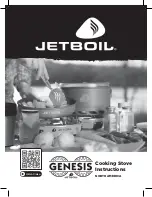
10
7061-196B
March 20, 2014
Explorer II Medium Wood Stove
G. Building A Fire
Before lighting your first fire in the stove:
1. Confirm the baffle is correctly positioned. It should be
even with the front tube and resting on all tubes.
Figure
11.1 and 11.2 on page 11.
2. Remove all labels from glass and inside of stove.
NOTE
: The special high temperature paint that your stove
is finished with will cure as your stove heats. You will
notice an odor and perhaps see some vapor rise from
the stove surface; this is normal. We recommend that
you open a window until the odor dissipates and paint is
cured.
There are many ways to build a fire. The basic principle is
to light easily-ignitable tinder or paper, which ignites the fast
burning kindling, which in turn ignites the slow-burning fire
-
wood. Here is one method that works well:
1.
Open the Burn Rate Air and Start-Up Air Controls fully.
2. Place several wads of crushed paper on the firebox floor.
Heating the flue with slightly crumpled newspaper before
adding kindling keeps smoke to a minimum.
3. Lay small dry sticks of kindling on top of the paper.
4. Make sure that no matches or other combustibles are in
the immediate area of the appliance. Be sure the room
is adequately ventilated and the flue unobstructed.
5. Light the paper in the appliance. NEVER light or rekindle
fire with kerosene, gasoline, or charcoal lighter fluid; the
results can be fatal.
6. Once the kindling is burning quickly, add several full-length
logs 3 inches (76mm) or 4 inches (102mm) in diameter.
Be careful not to smother the fire. Stack the pieces of
wood carefully; near enough to keep each other hot, but
far enough away from each other to allow adequate air
flow between them.
7. Set the Burn Rate Air Control and activate the timer
system (ACC).
8. When ready to reload, It is best to fully open both the Burn
Rate Air and Start-up Air Controls
before reloading
. This
livens up the coalbed and reduces excessive emissions
(opacity/smoke). Open door slowly so that ash or smoke
does not exit appliance through opening. Large logs burn
slowly, holding a fire longer. Small logs burn fast and hot,
giving quick heat.
9. As long as there are hot coals, repeating steps 6 through
8 will maintain a continuous fire throughout the season.
F. Burn Rates and Operating Efficiency
For maximum operating efficiency
1. This appliance has a timer system (ACC) that operates
the stove at its maximum efficiency removing any guess
work for the homeowner. Follow the instructions below
for each burn rate for the Start-Up Air Control and Burn
Rate Air Control.
Figure 9.1
2. Burn dry, well-seasoned wood.
Burn Rates
Primary control is open when moved to the left…
1. Low burn setting- Burn rate control on high for 5 min.
Activate the boost/startup air, then close burn rate con
-
trol to stop (move right)
2. Medium low burn setting- Burn rate control on high
for 5 min, Activate the boost/startup air, then 1/8”-1/2”
open (move left from low setting)
3. Medium high burn setting- Burn rate control on high.
Activate the boost/startup air, 1/2 – full open (move left
from low setting)
4. High burn setting: Burn rate control open (left) boost/
startup open.
Note:
1-3 burn settings the fan shall be off for the first 30
minutes and then be operated in the high position at 30
minutes. High burn setting, fan shall be may continue to be
on full after the loading of the fuel.
NOTE:
Due to altitude and other circumstances this
operation information is a guideline, units may run
settings not in accordance with these guidelines to
achieve same desired burn rates.
WARNING
Risk of Fire.
When set on High Burn Rate and over-riding the Auto
-
matic Combustion Control system an overfire situation
can occur and may result in a chimney fire.
Overfiring will void the stove warranty.
NOTE:
Operate appliance on High Burn 45 minutes a
day to help keep flue/chimney clean.
NOTE:
• Build fire on brick firebox floor.
• Do NOT use grates, andirons or other methods to support
fuel. It will adversely affect emissions.
WARNING
Fire Risk
Do NOT store wood:
• Closer than required clearances to combustibles to
appliance
• Within space required for loading or ash removal.
Do NOT operate appliance:
• With appliance door open.
• With ash removal system door open.
•
Do NOT burn wet or green wood.
•
Store wood in dry location.
•
Stack wood so both ends are exposed to air.
Wet, unseasoned wood can cause accumulation of
creosote.
Fire Risk.
WARNING











































